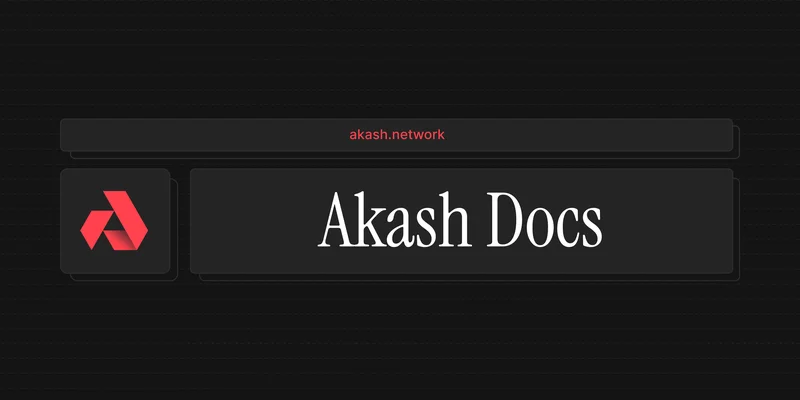Akash Network, a project at the heart of the decentralized compute (DePIN) narrative, just threw a wrench into its own engine. Founder Greg Osuri announced the project will be deprecating its native Cosmos chain and migrating to an entirely new network (Akash Network to deprecate its Cosmos chain, begin search for new network). This isn't a software update; it's a foundational shift, akin to a car manufacturer deciding to stop making its own chassis and instead build its vehicles on a competitor's platform.
The stated rationale is a search for a new home that offers “strong security, a high-quality community, deep liquidity and exciting growth.” On the surface, these are reasonable, if somewhat generic, corporate objectives. But for a project of this scale, such a move introduces a level of operational risk that cannot be overstated. It forces a critical question: Is this a necessary, forward-thinking evolution, or is it a solution in search of a clearly defined problem?
Let's deconstruct the official criteria. "Strong security" is table stakes for any serious blockchain project. "Deep liquidity" is quantifiable, but the announcement offers no benchmark for what "deep enough" actually looks like. And "high-quality community" is a subjective metric that’s nearly impossible to measure, often serving as a convenient catch-all for intangible goals. I've analyzed dozens of corporate restructurings, and vague justifications like "synergy" or "community" often mask a more pressing, less flattering core issue.
The move feels like a high-end software firm in Silicon Valley suddenly announcing a relocation to Austin. The public narrative would focus on a vibrant new tech scene and a better quality of life. The unspoken driver, however, would likely be escaping California's tax regime and exorbitant operating costs. So, what is Akash trying to escape? What specific performance metric or limitation within the Cosmos ecosystem has become so untenable that it justifies uprooting the entire project? The official statements are silent on this crucial point.
Mentioning Solana as a "strong contender" is particularly telling. While Osuri insists the new home will remain IBC-compatible, considering a non-Cosmos chain signals a potential willingness to trade seamless interoperability within its current ecosystem for the raw throughput and liquidity that a chain like Solana might offer. This isn't just changing neighborhoods; it's potentially changing nationalities and learning a new language. It's a massive architectural compromise.

The core of the DePIN thesis, as outlined in recent industry reports, hinges on reliability and scalability. A chain migration is, by its very nature, a direct threat to short-term reliability. The process will be "public and community-driven," which sounds collaborative but also introduces the risk of design-by-committee and a protracted, messy transition. What happens to the GPU providers and AI developers who rely on Akash's infrastructure during this period of uncertainty? Will they wait patiently, or will they migrate to more stable, centralized alternatives?
While the project's leadership grapples with these existential questions, the market appears to be telling an entirely different story. If you turn away from the strategic ambiguity of the announcement and look at the AKT price chart, you see a picture not of uncertainty, but of coiled potential.
As of early October 2025, AKT is carving out a falling wedge pattern on its daily chart (Akash Network (AKT) Testing Key Resistance – Could This Pattern Trigger an Bullish Breakout?). This is a classic bullish technical formation, suggesting that a multi-month consolidation period may be nearing its end. The price recently bounced cleanly off support near the $0.95 level and is now pressing up against the upper boundary of the wedge. You can almost feel the coiled-spring tension in the chart as the price gets squeezed between a rising floor of buyers and a descending ceiling of sellers.
The key level to watch is the 100-day moving average, currently sitting near $1.18. A decisive break above that mark would serve as confirmation, potentially triggering a sharp upward move. The projected target from a successful breakout sits near $1.50, representing a potential upside of over 40%—or more precisely, about 41.5% from its current price of $1.06. This creates a classic divergence between the fundamental picture (defined by long-term operational uncertainty) and the technical sentiment (driven by short-term price patterns).
It seems traders are either ignoring the migration news or, more likely, are pricing it as irrelevant in the near term. They are betting on the broader market updraft, with Bitcoin and Ethereum showing significant strength, and the undeniable momentum of the DePIN narrative itself. The chart is responding to sector-wide capital flows, not the internal politics of the Akash Foundation.
My analysis suggests we're witnessing a profound disconnect. The project's roadmap is now a massive question mark, filled with unquantifiable goals and an undefined timeline. The price chart, in contrast, is providing a clear, actionable signal. For now, the market has decided that the technical pattern and the tailwind from the AI and DePIN sectors are more important than the monumental risk of a base-layer migration. The fundamental questions about Akash's future are valid and deeply concerning, but they are a problem for another day. Today, the numbers on the screen are telling traders a much simpler story: buy the pattern, ride the momentum, and worry about the long-term consequences later. The real test won't be in the community forums, but in whether Akash can pull off this incredibly complex maneuver without shattering the trust of the very network participants it needs to survive.